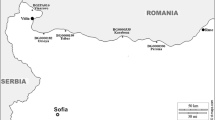Abstract
Conservation of biodiversity is one of the world’s highest priorities. Floristic studies help to quantify the botanical resources and better design strategies for plant conservation. We studied the vascular plant flora Burabay National Park, Kazakhstan: composition, life form classification and ecological groups (Burabay NP) to determine how this park contributes to conservation and restoration of local plant diversity. Flora study was carried out by route-recognostic method with use of the determinant. In short, a list of plant species of the Cladgrass Division by ladder species has been compiled and a total of 10 permanent sampling plots were established across Burabay NP representing all main vegetation types (steppe, mountain steppe, meadow steppe and forest steppe). Sites have been re-sampled since 2018 until now, at intervals of every 10–15 days from April to October. Moreover, we have made field survey every summer that yielded further collections and complement the data from the regularly visited monitoring plots. The floristic composition of the park includes six types of life forms: trees, bushes, semi-shrubs, perennial grasses, biennial and annual species. The flora’s park is represented by xerophytes (36.34%), mesophytes (36.05%), hygrophytes (18.9%) and hydrophytes (8.72%). Burabay National Park is an oasis in the steppe, with a wide representation of hygrophytes and hydrophytes. Therefore, it should be prioritized in strategies of conservation.






Similar content being viewed by others
References
United Nations, Convention on Biological Diversity. https://www.un.org/ru/documents/decl_conv/conventions/biodiv.shtml
Lughadha EN (2004) Towards a working list of all known plant species. Philos Trans R Soc Lond Ser B: Biol Sci 359(1444):681–687
Rachkovskaya EI (1968) The main zonal types of steppes of Central Kazakhstan. In: Proceedings of interuniversity symposium. "Studying of nature of steppes. Odessa. C. pp 83–84
Khusainov AT, Memeshov SK, Durmekbaeva ShN, Makhanova SK, Fakhrudenova IB, Kurmanbaeva AS, Khusainova RK (2019) Current ecological state of the State National Nature Park "Burabay" and measures for its improvement. Monograph.—Kokshetau
Mace GM (2004) The role of taxonomy in species conservation. Philos Trans R Soc Lond Ser B: Biol Sci 359(1444):711–719
Ebel AL (2011) Flora of the northwestern part of the Altai-Sayan province: composition, structure, origin, anthropogenic transformation: Author's abstract. Tomsk
Chape S, Harrison J, Spalding M, Lysenko I (2005) Measuring the extent and effectiveness of protected areas as an indicator for meeting global biodiversity targets. Philos Trans R Soc B: Biol Sci 360(1454):443–455
Jakovljević K, Tomović G, Djordjević V, Niketić M, Stevanović V (2020) Steppe flora in Serbia–distribution, ecology, centres of diversity and conservation status. Folia Geobot 55(1):1–14
Baranov VI (1925) Southern border of chernozem steppes in Kustanay province: [according to research data of 1923]. Orenburg. 36 c. (People's commissariat of agriculture. [Research series. No 5])
Karamysheva ZV, Rachkovskaya EI (1973) Botanical geography of the steppe part of Central Kazakhstan. Nauka
Krasheninnikov IM (1925) Vegetation cover of Kyrgyz Republic. Orenburg
Kurochkina LY, Stepanova EF (1956) Vegetation of virgin lands in the north-western part of Akmola oblast. Proc Inst Bot Acad Sci Kazakh SRR 4:3–46
Pavlov NB (1948) Botanical geography of the USSR. Alma-Ata 710:7
Rachkovskaya EI (2016) Deserted sagebrush-grass steppes of Central Kazakhstan Vegetation of Russia. SPb 28:108–124
Rubtsov NI (1952) Vegetation cover of Kazakhstan Essays on physical geography of Kazakhstan. J Geogr Environ Manag 1(44):2017
Sobolev LN (1948) Natural forage lands of Kazakhstan. Alma-Ata 288, p 9
Memeshev SK, Khusainov AT, Sattybaeva ZD, Durmekbaeva ShN, Serikov SI (2019) Soils of the State National Nature Park "Burabay". Monograph. 14 p
Tolmachev AI (1986) Methods of comparative floristics and problems of florogenesis. Nauka, Novosibirsk
Takhtajan AL (1987) System of Magnoliophyta. — Leningrad: Nauka
Cherepanov SK (1995) Sosudistye rasteniya Rossii i sopre-delnykh gosudarstv (Vascular plants of Russia and adja-cent states). St. Petersburg, p 992 (in Russian)
Serebryakov IG (1962) Ecological morphology of plants. Moscow: High School 378 p
Raunkiaer C (1934) The life forms of plants and statistical plant geography: being the collected papers of C. Raunkiaer. Oxford, UK: Clarendon Press. https://books.google.co.uk/books?id=LJj9swEACAAJ
Baitenov M.S. (1999). Flora of Kazakhstan. Almaty Gylym. 1–2
Stump LD (1976) Dictionary of general geographical terms. T. 2. Progress, Moscow
UNESCO, 2021, https://en.unesco.org/biosphere/aspac
Kirschner J, Skalický V (1989) Notes on viola in the new flora of the czech lands. Preslia 61:315–319
You G, Liu B, Zou C, Li H, McKenzie S, He Y et al (2021) Sensitivity of vegetation dynamics to climate variability in a forest-steppe transition ecozone, northeastern Inner Mongolia. China. Ecol Indic 120:106833
Davydov DA, Gomlya LM (2020) Floristic diversity of steppe territories near Poltava town (Ukraine). Biosyst Divers 28(1):81–91
Jakovljevic A, Nikolic N, Carkic J et al (2020) Association of polymorphisms in TNF-α, IL-1β, GSTM and GSTT genes with apical periodontitis: is there a link with herpesviral infection?. Int Endod J 53:895–904
Kirschner P, Záveská E, Gamisch A, Hilpold A, Trucchi E, Paun O, Schönswetter P (2020) Long-term isolation of European steppe outposts boosts the biome’s conservation value. Nat Commun 11(1):1–10
Acknowledgements
We extent our sincere thanks to administration and colleagues from Burabay National Park, who made this research possible.
Author information
Authors and Affiliations
Corresponding author
Ethics declarations
Conflict of interest
The authors declare that they have no conflict of interest.
Additional information
Publisher's Note
Springer Nature remains neutral with regard to jurisdictional claims in published maps and institutional affiliations.
Significance’ statement: Data sharing not applicable – no new data generated.
Rights and permissions
Springer Nature or its licensor (e.g. a society or other partner) holds exclusive rights to this article under a publishing agreement with the author(s) or other rightsholder(s); author self-archiving of the accepted manuscript version of this article is solely governed by the terms of such publishing agreement and applicable law.
About this article
Cite this article
Khussainov, A.T., Shulembayeva, K.M., Durmekbayeva, S.N. et al. The Vascular Plant Flora Burabay National Park, Kazakhstan: Composition, Life Form Classification and Ecological Groups. Proc. Natl. Acad. Sci., India, Sect. B Biol. Sci. (2024). https://doi.org/10.1007/s40011-024-01550-2
Received:
Revised:
Accepted:
Published:
DOI: https://doi.org/10.1007/s40011-024-01550-2




